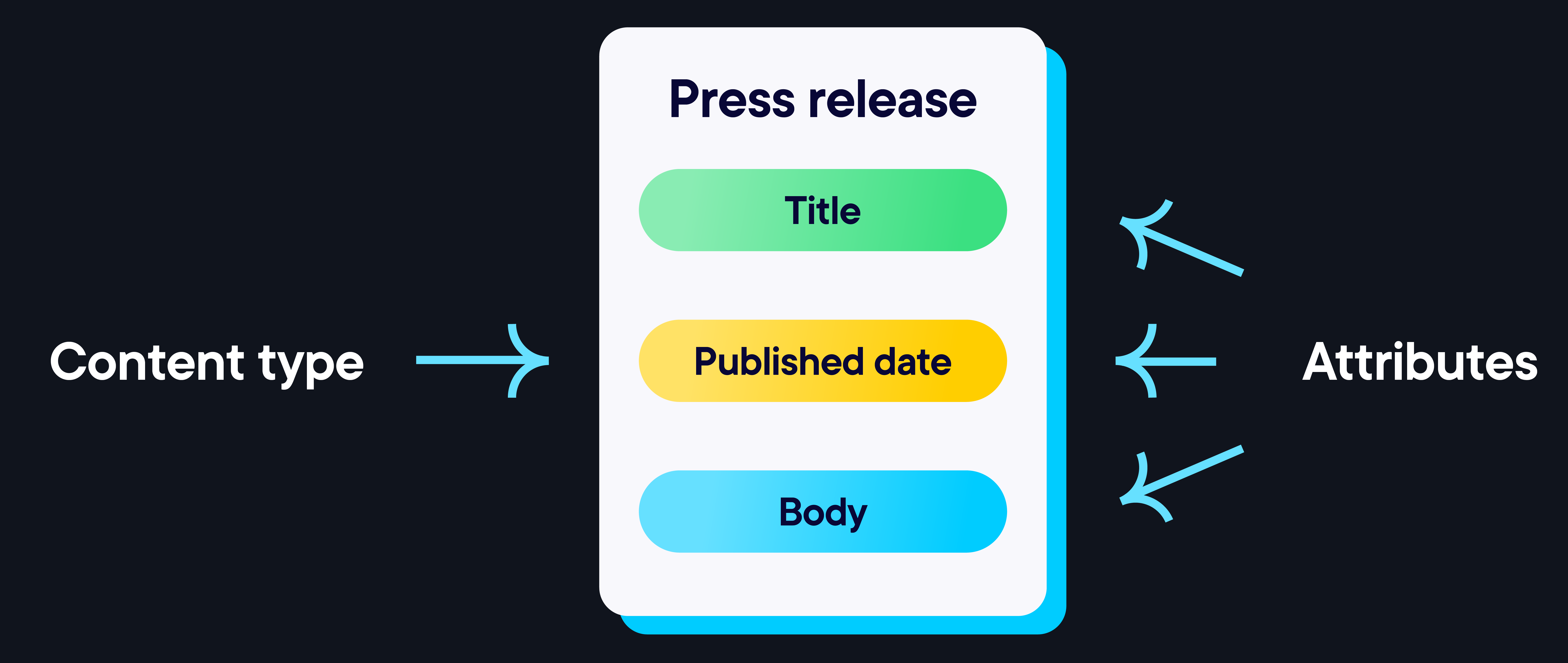Content modeling 101: The essential guide for busy marketers


Managing content efficiently across a million and one (okay, I might be slightly exaggerating…) platforms. Feels a bit like you’re on a treadmill that’s permanently set to “run for your life.” 😅😓
Enter content modeling — a strategic way to structure your content so it’s easier to manage, scale, and repurpose across pretty much any channel you can think of. If we’ve piqued your interest, then keep on reading on.
Because we’re here to break down the basics of content modeling, why it’s important, and how it can benefit both marketers and developers. And (just because we’re helpful like that) we’ll also walk you through how to create your content model, a few sneaky pitfalls to avoid, and some best practices to ensure your model can be scaled properly as needed. Plus, we’ll touch on how emerging tech like AI and personalization can make content modeling even more powerful.
By the end of this guide, you’ll have a clear roadmap for implementing a content model on your own website. Time to grab your favorite caffeinated beverage and settle in — let’s get into all things content modeling.
What the heck is content modeling (and why should you care)?
Content modeling sounds a bit mysterious and techy, but, we promise, it’s really not. In its simplest form, content modeling is the process of defining the structure of your content, so it’s easier to manage, edit, and reuse across different platforms. Rather than thinking of all of your website content as one big, jumbled mess of text, images, and links, a content model breaks everything down into reusable, modular components.
It’s a little like building with Legos (although we do have to admit, not quite as much fun). Each content piece, whether it’s a product description, testimonial, or blog title, has its place, and you just mix and match away to create different types of content.
But what’s the “so, what?” for us marketers, I hear you say? Well, how about this: a content model means you don’t need to start from scratch every time you need to launch a new campaign. Instead, you can pull from your handy library of preapproved, on-brand content blocks to create engaging experiences on the fly. Pretty nifty, huh?
Why content modeling is your marketing lifesaver (no, really)
In today’s omnichannel world, your audience isn’t just hanging out on your website. These guys are all over the place — scrolling through social media, opening emails, talking to smart devices, and browsing mobile apps. If you’re creating unique content for each of these platforms from scratch, well, you’re going to need more than that cup of coffee to keep up. 🏃♀️
Content modeling allows you to manage and deliver content that’s optimized for all these touchpoints. And that’s without doubling — or (perish the thought) tripling — your workload. And, just as importantly, content modeling ensures you’re delivering consistent brand experience across every channel. So, whether your audience is having a browse of your site or scrolling through their Instagram feed, every touchpoint feels super aligned with your brand’s tone, style, and messaging.
How content modeling can save your sanity (and give you back your time)
Now that we’ve covered the basics, let’s talk about why content modeling is worth doing. Because content modeling ain’t just a fancy buzzword, guys.
- For marketers: Content modeling offers speed, consistency, and ease of personalization. Instead of constantly reinventing the wheel, you can reuse blocks of content. That means faster campaign launches and the ability to personalize content for different audience segments, without breaking a sweat (or your brain).
- For developers: A well-structured content model makes it easier for your dev team to manage updates and content changes without scrambling to fix broken code every time. It also means that scaling your website, adding new content types, or introducing new features can be done seamlessly, without needing a total site overhaul. Side benefit: devs end up spending a whole lot less time on routine updates and more of their limited resources on building features that can add real value.
The basics of content modeling
Okay, so you’re sold on content modeling. But how exactly does it work? Happy you asked, because we're about to break it down for you.
Content types
Content types are the different formats your content takes — we’re talking blogs, product pages, case studies, team bios, and everything in between. Each type of content your brand creates falls under a distinct content type. If you’re running an ecommerce website, you might have a lot of content like product pages, customer reviews, and how-to guides. If you’re working at a SaaS company, you might be churning out things like whitepapers, blog posts, and case studies. Each content type comes with a unique set of requirements and fields, but they all follow a consistent structure.
(Honestly... how many times can we use the word “content” in a paragraph. 🤦)
Fields
Fields represent the individual pieces of info within a given content type. These might be text fields ( “headline” or “body copy”), media fields ( “image” or “video”), or even more specialized fields like dates or tags. Having clearly defined fields helps keep your content organized and consistent.
Relationships
Relationships are what make your content both dynamic and interconnected. For instance, a product page should ideally link to related blog posts or customer stories. Defining these relationships creates a more integrated user experience, allowing customers to seamlessly navigate between related pieces of content.
The idea behind all of this is that, when you create a piece of content using your content model, the CMS can pull from predefined content types and fields, making sure everything is where it needs to be. In a traditional CMS, content tends to be stored as static pages, making it difficult to repurpose. But with a content model, each content field lives independently, which gives you a whole lot more flexibility when it comes to reusing and remixing content across different platforms and devices.
Forrester Wave™ for CMS
How to get started with content modeling
Now that we’ve covered the theoretical stuff, let’s roll up our sleeves and get to the practicalities.
-
Identify your key content pieces
Think about the types of content your brand produces regularly. Is it blog posts, product descriptions, case studies? Start with these.
-
Define the fields for each content type
For each content type, think about the fields you’ll need. If you’re mapping out a content model for a blog post, for example, you’ve got things like the headline, body text, author, and publish date. No need to get too granular, though. You want enough structure to keep the consistency going, but not so much that your content model becomes unwieldy.

Image source: Optimizely -
Establish relationships between your content types
Decide how your content types relate to each other. Should blog posts link to author bios? Should product pages link to customer reviews? These relationships will not only make your content feel more connected, they’ll also make for a better user experience.
-
Map the content model to your CMS
Ahhh, the best step of all — the last step! This involves integrating your content model into your CMS. This is where you’re standardizing content creation, improving team efficiencies, and making sure all your content fits into your defined structure. Once your content model is in place, you’ll wonder how you ever managed without it.
Common mistakes in content modeling (and how to avoid them 🫸)
Please, we beg of you, don’t:
- Overcomplicate your model: Keep it simple. Don’t try to create a model that accounts for every single scenario, or you’ll just end up with a bit of a mess that’ll be more of a hindrance than a help.
- Fail to plan (for the future): Your brand’s content strategy will evolve, so make sure your model is flexible enough to adapt. Think about how new channels, like voice search or a mobile app, could impact your content model down the line.
- Ignore cross-channel: Remember, your content won’t just live on your website. So make sure your model is set up for multi-channel distribution, whether that’s email, social media, or whatever platform comes next.
TL; DR: Content modeling best practices
- Keep it simple, but scalable: A clean, simple model is easier to maintain and more efficient. Start small but leave room for growth. This ensures your content model can expand as your business needs shift.
- Ensure consistency across your content types: A well-structured model ensures that content looks and feels consistent across every platform and touchpoint. This strengthens your brand and improves the user experience.
- Plan for localization and personalization: If your brand is global or personalizes content for specific audiences, make sure your model can account for variations in language, region, and user preferences.
The future of content modeling 🔮
As we try to gauge where content modeling is going, two major trends stand out: the rise of AI and automation, and the increasing demand for personalization.
Let's be real here, we make some pretty big asks of our marketing teams. We're tasked with delivering personalized experiences at scale, while also managing a growing list of platforms and channels. This is where the future of content modeling gets exciting — it’s about more than just organizing content, it’s about leveraging technologies to enhance efficiency, creativity, and user experience.
AI and automation
The future is here, and it involves a lot more AI than we probably imagined just a couple of years ago. Picture AI helping you suggest fields, ways to optimize your content, or create personalized versions for different audience segments. Pretty cool, right?
With AI embedded into your content model, it could potentially learn from your data, fine-tuning content recommendations for specific user segments and even adjusting how and where content is served up based on user behavior. Integrating AI into your marketing strategy can enhance these capabilities, providing smarter automation and more targeted content.
Automation also plays a major role in scaling content production. For instance, AI-powered content creation tools can now automatically generate product descriptions or blog posts based on a predefined content model, letting you focus on more strategic stuff instead of writing and rewriting content ad nauseum.
Personalization
With so much content competing for attention, audiences expect brands to deliver digital experiences that speak directly to them. A flexible, well-structured content model is key to delivering the right content to the right audience, at the right time, across pretty much any channel you like.
Whether it’s adjusting messaging for different audiences or delivering region-specific content in multiple languages, a well-designed content model is what can make personalized marketing on a grand scale truly possible. Developing a personalization strategy can further enhance these efforts, ensuring that each user feels uniquely catered to.
And the future? Well, it’s only going to get brighter as AI and personalization work together to create experiences that are hyper-targeted, responsive, and let’s be honest — kinda mind-blowing.
Ready, set, model
Content modeling may sound intimidating, but it doesn’t have to be. Start small, build a model that suits your needs, and watch as your content becomes more organized, efficient, and ready for whatever challenges gets throws its way.

